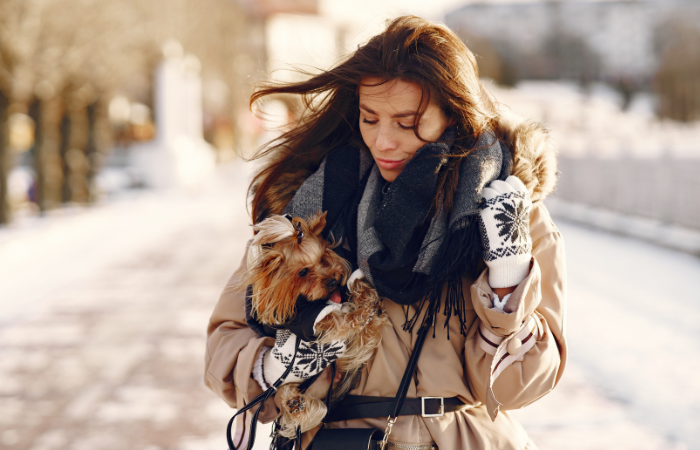Winter Woofs: 7 Tips to Keep Your Pup Cozy and Warm

Winter is here, and while we may be bundling up in cozy sweaters and warm jackets, our furry friends need some extra care too. As the temperature drops, we must keep our dogs warm. We'll discuss seven ways to keep your dog warm in winter.
From winter coat selection to nutrition changes, we have everything you need to keep your dog comfortable and happy this winter. We'll discuss protecting their paws from cold surfaces, fun indoor toys to keep them busy, and how to create a safe and comfortable sleeping place. With these tips, you can keep your pet warm and enjoy winter. Learn how to keep your dog warm and comfy this winter to avoid the winter blues.
Signs that your dog is feeling cold
Just like us, dogs become cold in winter. Some dog breeds can survive colder temperatures, but they still need extra clothing in winter. Freezing temperatures can induce frostbite, hypothermia, and other health problems. Warmth can keep your dog happy and healthy.
Being able to identify when your dog is feeling chilly is crucial. Shivering, curled into a ball, looking for warmth, and elevating their paws off the ground are a few typical symptoms. It's time to intervene and provide them with greater comfort if you observe any of these symptoms.
Tips for Creating a Warm and Cozy Environment for Your Dog
In winter, your dog needs a warm, cozy space. This can be achieved with a comfy bed with lots of blankets and cushions. Consider a heated blanket or bed to keep them warm.
Choosing the Right Clothing for Your Dog in Winter
Dogs can benefit from wearing winter clothes, just like people can. Choose a winter coat for your dog that covers their whole body, is warm, and waterproof. During walks, this will assist keep them dry and shield them from the cold. It's also essential to ensure that the coat fits properly and doesn't restrict their movement.

Indoor Activities to Keep Your Dog Active and Warm
You can't always spend as much time outside with your dog in the winter. Indoor activities like hide-and-seek and puzzle games can keep kids busy. You can also set up indoor obstacle courses or teach them new tricks. Mental stimulation is just as important as physical exercise, so be sure to provide plenty of both.
Winter Grooming Tips for Your Dog's Coat
Proper grooming is crucial for your dog's coat during winter. Regular brushing helps remove dead hair and stimulates blood circulation, promoting a healthy and shiny coat. Do not over bathe your dog, since this may deplete their coat of important oils that keep them warm. Dry your dog after a stroll if they get wet. This prevents chilling.
Safety Precautions for Winter Walks with Your Dog
You and your dog can walk casually in winter, but be careful. Check the temperature before leaving. Cold weather calls for shorter walks. Protect your dog's paws by applying paw balm or using protective booties. Be cautious of icy surfaces and avoid walking on them if possible. Lastly, make sure your dog is visible by using reflective gear, especially during the darker winter months.

Nutritional Considerations for Your Dog in Winter
Your dog's food may change in winter. The cold weather may require more calories to stay warm. Your vet can tell you if your dog's nutrition needs to adjust in winter. Additionally, make sure they have access to fresh and unfrozen water at all times.
Common Winter Health Issues in Dogs and How to Prevent Them
Winter can bring about specific health issues in dogs. One common problem is dry and cracked paws. To prevent this, regularly apply paw balm and wipe their paws after walks to remove any salt or chemicals from the roads. Dry skin is another problem that can be resolved by supplementing your dog's diet with fish or coconut oil. Finally, watch for symptoms of frostbite or hypothermia and seek veterinarian attention if necessary. With these tips, you can keep your pet warm and enjoy winter.
Choosing the right clothing for your dog in winter
Your dog needs a warm, comfortable space in winter. Dogs need a warm space to relax like people. Ideas for furnishing your pet's ideal winter refuge.
- Invest in a cozy bed: Provide your pup with a warm and comfortable bed to curl up in. Look for beds with plush materials and extra padding to keep them off the cold floor. Consider heated beds for added warmth, especially for older dogs or those with joint
- Keep drafts at bay: Cold drafts can make your dog uncomfortable and even lead to health issues. Check your windows and doors for any gaps or leaks that let cold air in. Use draft stoppers or weather stripping to seal off any drafts and create a cozy space for your
- Use blankets and sweaters: Just like we bundle up in layers during winter, dogs can benefit from extra warmth too. Provide your pup with blankets and sweaters to help retain their body heat.
Indoor activities to keep your dog active and warm
When it comes to keeping your pup warm during winter walks, choosing the right clothing is essential. Here are some tips to consider when selecting winter attire for your furry friend.
- Size and fit: Ensure that the clothing you choose fits your dog properly. It shouldn't be too tight or restrictive, as this can cause discomfort. Measure your dog's neck, chest, and length to find the right size. Remember that not all dogs will need clothing, so observe your pup's behavior to determine if they require extra
- Waterproofing and insulation: Seek out winter jackets and coats that are both waterproof and insulated. These will shield your dog from wind, rain, and snow while also keeping them warm.
- Consider Visibility and Safety: Choose clothing with reflective strips or bright colors to ensure your dog is visible during walks in low light conditions. This is especially important during shorter daylight hours in winter. Additionally, make sure any clothing you choose doesn't hinder your dog's mobility or cover their eye.

Winter grooming tips for your dog's coat
Furry Friends must be kept active even when they can't spend as much time outside. These indoor activities can keep your dog warm and busy in winter.
- Interactive toys and puzzles: Invest in interactive toys and puzzles that challenge your dog mentally and physically. These toys can keep them entertained and provide mental stimulation during their indoor time. Look for toys that dispense treats or require problem-solving
- Indoor agility courses: Set up a mini agility course indoors using household items such as chairs, tunnels, and jumps. This can be a fun way to keep your dog active and provide them with exercise even when they can't go outside. Use treats and positive reinforcement to encourage them through the
- Training sessions: Winter is a great time to work on your dog's obedience and training. Spend some extra time teaching them new commands or reinforcing existing ones. This not only keeps them mentally engaged but also strengthens the bond between you and your furry friend.
Safety precautions for winter walks with your dog
Dog coat health depends on proper care, especially in winter. Take care of your dog's coat in the cold with these grooming suggestions.
- Regular brushing: Brush your dog's coat regularly to remove loose fur, tangles, and mats. This helps to distribute natural oils and keeps their coat healthy and shiny. Brushing also improves blood circulation and helps to remove dry
- Bathing frequency: Reduce the frequency of baths during winter, as excessive bathing can strip away essential oils from your dog's skin. Opt for dry shampoos or spot cleaning to keep them fresh between baths. If you do bathe them, ensure they are completely dry before going outside to prevent them from getting
- Moisturize their skin: Cold weather can dry out your dog's skin, leading to itchiness and discomfort. Keep dog skin nourished with a moisturizing shampoo or conditioner. Coconut oil promotes healthy skin and coat, so add a little to their diet.

Nutritional considerations for your dog in winter
You can walk your dog in winter, but be careful. Next time you travel with your pet, remember these tips.
- Paw protection: On sidewalks and roads, salt, ice, and snow can injure your dog's paws. Consider using booties to protect their feet from the cold and prevent ice buildup between their toes. If booties aren't an option, apply a protective paw balm before and after walks to create a barrier.
- Stay visible: During winter walks, visibility is crucial, especially in low light conditions. Use a reflective leash and collar, or attach a reflective vest to your dog's clothing. This will make them more visible to motorists and other
- Avoid icy surfaces: Exercise caution when walking on icy surfaces, as they can be slippery and pose a risk of injury. Stick to cleared pathways and avoid areas with thick ice. If your dog tends to pull on the leash, consider using a harness for better
Common winter health issues in dogs and how to prevent them
Your dog's health, particularly winter warmth, depends on what they eat. These are winter dog nutrition considerations:
- 1. Adjust portion sizes: Winter lowers your dog's activity levels, so adjust his portion sizes. Do not overfeed them as they may gain weight. Talk to your vet about portion sizes for your dog's age and breed.
- Feed your dog warming foods: Warming meals makes your dog feel good. Boiling veggies, bone broth, and lean meats help warm you in winter. Always keep in mind any dietary restrictions or allergies your dog may have.
- 3. Stay hydrated. Dogs can easily become dehydrated in winter since they're less thirsty. Always provide clean water to kids. Try a hot food or slightly heated water to entice them to drink.
Conclusion:
During winter, dogs can face health issues such as hypothermia, frostbite, and dry skin. To prevent hypothermia, limit outdoor time in extreme cold and provide a warm indoor space. Protect against frostbite by avoiding extreme cold or using protective clothing, and contact a vet if frostbite is suspected. Address dry skin by humidifying the environment, adding omega-3 supplements to the diet, and maintaining regular grooming and moisturizing routines.

